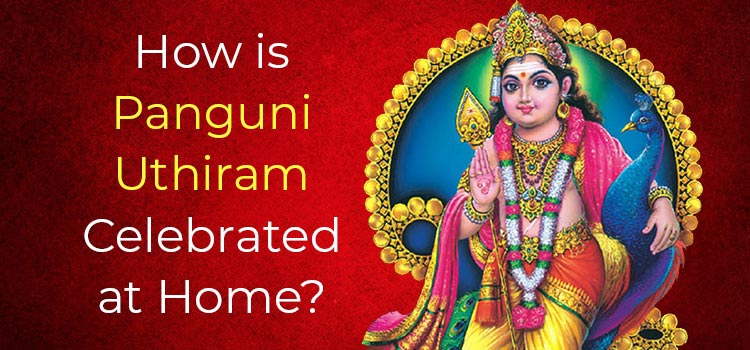How is Panguni Uthiram Celebrated at Home
How to celebrate Panguni Uthiram at Home:
According to the Tamil calendar, Panguni is the last month of the year. What is unique about this Tamil festival is the convergence of the Uthiram Nakshatra(star) and Poornima (Full Moon day). It falls in the month of Panguni (Phalguni), which lasts from mid-March to mid-April. In Sanskrit, it is also known as Meena Uttara Phalguni. The Moon transits in the Uthiram nakshatra on this day. Panguni Uthiram holds significance both for Shaivites and Vaishnavites.
The day is also very auspicious as it celebrates Kalyana Vrata festival, one of the eight Maha Vratas in the Skanda Purana. This auspicious Vrata is observed when the Sun is in Meena Rashi (Pisces) in Uthiram nakshatra, during the Shukla Paksha (waxing moon phase). It is a very important day celebrated across Tamil Nadu, Andhra Pradesh, Karnataka, and Kerala. This annual festival is dedicated to Muruga, the main deity of this festival. Thousands of devotees visit Murugan temples on this day.

Kalyana Vrata festival is very auspicious, witnessing the grand celestial wedding of divine couple Lord Shiva and Goddess Parvati (King Himavat's daughter). The day is also celebrated as Gauri Kalyanam. It was also the day when Muruga and Devasena were married. The day also witnessed the divine weddings of Andal and Sri Rangamannar, Sita Devi, and Sri Rama.
People celebrate Panguni Uthiram with great zeal and enthusiasm.
In Kerala, they wake up early in the morning and do meditation on Shiva with his divine consort, Goddess Parvati, in the wedding image. Then, they take an auspicious bath before offering worship. The idols of Shiva and Goddess Parvati are kept in the Pooja Sthal. They are in metal and worshipped with sacred elements. The idols are decorated beautifully with jewelry and flowers. Prasad (sacred food offerings), sweets and other delicacies are made to the divine couple.
Devotees prepare a special feast and invite other married couples to witness the pooja. They distribute the Prasad among them. Later, the individual who performs the pooja visits the nearest Shiva temple and prays for his divine blessings. The devotee must prostrate and perform three circumambulations before the deity. As part of the ritual, devotees must sleep on the darbari grass at night. The next morning, after completing all chores, the ritual observer can donate Shiva and Goddess Parvati's idols to another devout follower. Those observing the ritual of Kalyana Vrata can be bestowed with the divine blessings of Shiva.
In Tamil Nadu, devotees keeping the Vrat wake up early and take a holy bath. They then clean and prepare the Pooja Sthal (meditation altar) and install the image or picture of Murga. The deity is decorated beautifully, the lamp is lit, and the pooja is performed. Chanting of sacred hymns includes Skanda Shashti Kavacham and Subramanya Kavacham, besides other sacred mantras are recited.
The offerings include fruits, coconut, betel leaves, flowers, nuts, turmeric rice, and Prasad. Traditionally, dishes of Paruppu Payasam or Sweet Pongal are the offerings made to the deity. Prasad is partaken after the pooja. Devotees can fast the whole day or consume fruits if required. Devotees undertake a pilgrimage to Murugan temples by walking barefoot, covering long distances. Some of them carry 'Kavadi' (short wooden pole surmounted by wooden arch) containing pooja elements to offer at the temple. Lord Murugan is widely worshipped on this auspicious day. It is a time for repentance by devotees.
Young men performing the Kalyana Vrata and young women observing the fast can attain life partners they desire. Couples can be blessed with good children. Other effects of this Vrata are removal of obstacles, growth, success, happiness, and wealth. It is believed even Gods and Goddesses observe this Vrata to attain good spouses. Kalyana Vrata, also known as Phalguni Poornima, is celebrated as the Holi festival in the Braj region, including Mathura, Vrindavan, Nandagon, and Barsana. There is a traditional belief that continuous observance of this Vrat for 48 years can liberate devotees from the cycle of birth and death.




















